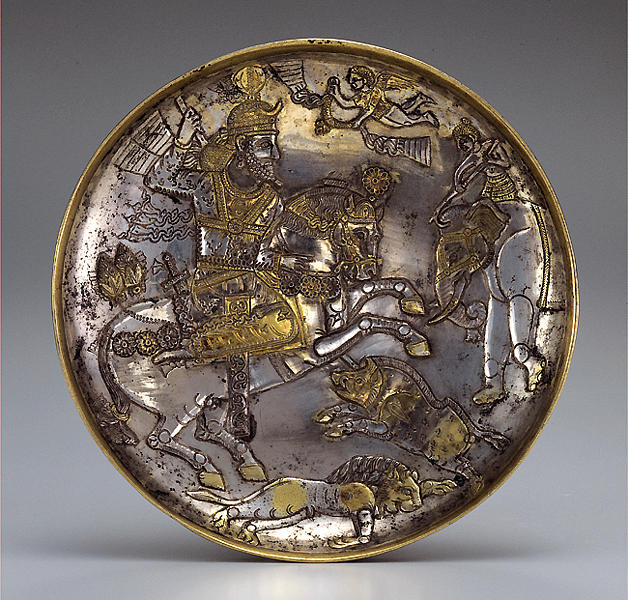
Shop Amazon - Create an Amazon Baby Registry
'Shumei Plate'
A post Sasanian plate with a king hunting lion and boar, 7th century.
Miho Museum, Japan



Title Plate with a King Hunting Animals Provenance Iran (?) Period Persia, Late or Post - Sassanid period Year 7th century Materials Silver gilt Dimensions Height-4.4 Diameter-20
This extraordinary example of silver craftsmanship depicts the theme of the Sasanian royal hunt in a distinctively decorative style, almost totally filling the circular field with pictorial elements. In this highly conservative genre, the central image is always that of a ruler engaged in hunting on foot or, more commonly, on horseback. Earlier royal hunting plates tend to be simple compositions featuring the king and one or more animals of the same species; but later versions tend to be more complex and often include animals of differing types. In this example, a dead lion and a charging boar are seen beneath the body of the rearing horse. The royal huntsman holds his leg up to avoid the beast while thrusting a spear through its body. In an odd and totally unnaturalistic fashion, the spear, which is held only in his right hand, passes behind his body to stab the boar. Entering the scene on the right is a caparisoned elephant driven by a mahout. It is reminiscent of the elephants depicted herding wild beasts in a royal hunting scene carved in low relief on a side wall of the large rock-cut niche at Taq-i Bostan, created during the reign of Khosro II (r. A.D. 591-628). A small winged genius bearing a ribboned necklace flies toward the royal personage to bestow it on him as an emblem of victory.
Hammering, carving, and chasing were techniques utilized to produce this work, without the addition of any separately made pieces to heighten the relief. This suggests a late date for its creation. Various technical characteristics such as the low relief and use of spot gilding are consistent with a late Sasanian date. A variety of sizes of circular punch marks decorate the hair, tied beard, diadem, necklace, chest halter, sword, belt, and other elements of the royal image. The long-tailed ribbons flying from the back of the diadem, the streamers from the back of the figure's chest halter, the scalloped edges of his diaphanous costume with parallel line and V-shaped wrinkles in the material shown here are characteristic of the remarkably consistent elements of royal imagery in silverwork repeated throughout the Sasanian era. The horse's harness is especially ornate, with emphasis given to the band of large high relief rosettes carved across his neck and rump. Even the tiny winged genius has been given a short-sleeved tunic with a dotted pattern.
The headdress depicted on this plate is not recognizable as that of any known Sasanian ruler. The diadem with two bands of pearls and a crescent on the front is first depicted on royal busts from coin issues of first reign of Kavad I (488-97); but the body of the crown seems to be derived from a very rare curled-cap crown found on a few coins of earlier kings.1 These caps, however, do not have globes on the top, as do most official Sasanian crowns. Thus the crown worn by this figure appears to be made up of elements of several types.
The composition of this plate is very close to that of a silver plate in the Museum fur Islamische Kunst, Berlin; although in this case a short javelin is held by the hunter in a convincing manner, and pointed at a bear standing behind a tree.2 In the Shumei plate the bear is replaced by the elephant and its driver. Also notable is the fact that the crown depicted on the Berlin plate is entirely different. Most puzzling, however, is the fact that the styles of the Berlin plate and the Shumei plate are unquestionably dissimilar. One possible solution to this problem could have been the use of a common prototype for both compositions. The Berlin plate was found in Armenia; but it is probable that drawings of silverwork designs circulated widely, making it possible for artisans from workshops in various locations to be similarly inspired.
Although the craftsmanship of this silver plate displays great skill, it is so highly syncretic in style that it does not fit comfortably within any of the stylistic categories of Sasanian silver plates proposed by Harper.3 Indeed, it may be the creation of a transitional era, not long before or after the fall of the Sasanian dynasty in the mid-seventh century, when oversight of official workshops had become slack or had come to an end, but at a time when high quality craftsmanship in silver might still be found, kept alive through private commissions of patrons nostalgic for reflections of a lost era of Sasanian royal glory. In fact, it might have been created to represent a Sasanian king from the distant past who, like Varahran V (Bahram Gur), became a subject of tales of heroic hunting exploits in later times. Legends such as these were part of an Iranian tradition surrounding the great deeds of its kings that survived long into the Islamic era to be crystallized in the epic of the Shah nameh.
MLC
1. Gl 1971, Table XIV.
2. Harper and Meyers 1981, pp. 68-70, p. 131, pl. 20.
3. Ibid., pp. 187-94.
Source: Miho Museum, Japan